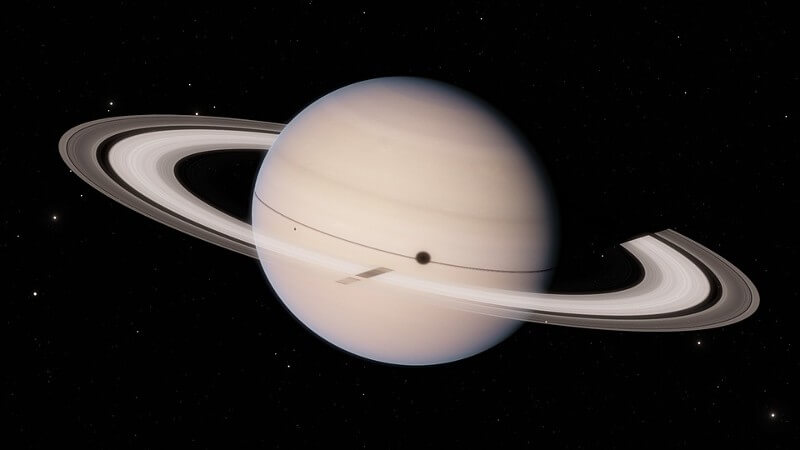A recent study spearheaded by physicist Sascha Kempf from the University of Colorado Boulder has provided the most compelling evidence to date indicating that Saturn’s rings are surprisingly young. This potentially resolves a mystery that has perplexed scientists for over a century.
The research, due for publication on May 12 in Science Advances, estimates the age of Saturn’s rings to be no more than 400 million years old. This suggests the rings are significantly younger than Saturn itself, which is approximately 4.5 billion years old.
Kempf, an associate professor in the Laboratory for Atmospheric and Space Physics (LASP) at CU Boulder, said that the study provides a resolution to a question that originated with James Clerk Maxwell.
The team achieved this resolution by studying an unexpected subject: dust. According to Kempf, tiny particles of rocky material constantly flow through Earth’s solar system. Sometimes, this flux can deposit a thin layer of dust on planetary bodies, including the ice that composes Saturn’s rings.
In their latest research, Kempf and his colleagues endeavored to date Saturn’s rings by observing the rate at which this layer of dust accumulates, akin to estimating a house’s age by checking for dust on its surfaces.
Kempf compared the rings to the carpet in a house, explaining that if you have a clean carpet, all you have to do is wait for the dust to settle. The same principle applies to the rings.
The process was laborious. From 2004 to 2017, the team used the Cosmic Dust Analyzer on NASA’s late Cassini spacecraft to examine dust particles around Saturn. Over those 13 years, the researchers gathered only 163 grains that had come from outside the planet’s immediate vicinity. However, this was sufficient. Their calculations suggest that Saturn’s rings have been accumulating dust for only a few hundred million years.
In essence, the planet’s rings are a relatively recent phenomenon, appearing (and potentially disappearing) in what is essentially a blink of an eye in cosmic terms.
Despite knowing the approximate age of the rings, Kempf admitted that many questions remained unanswered, such as the initial formation of these rings.
From the time of Galileo to the Cassini mission, researchers have been fascinated by these seemingly transparent rings for over 400 years. In 1610, Italian astronomer Galileo Galilei first spotted these features through a telescope, although he didn’t recognize them. In the 19th century, Maxwell, a Scottish scientist, deduced that Saturn’s rings couldn’t be solid but were instead composed of numerous individual pieces.
It’s now known that Saturn boasts seven rings made up of innumerable chunks of ice, most no larger than a boulder on Earth. This ice, in total, weighs roughly half as much as Saturn’s moon Mimas and spans nearly 175,000 miles from the planet’s surface.
Kempf noted that for much of the 20th century, scientists believed the rings likely formed contemporaneously with Saturn. However, this theory raised several issues, especially given that Saturn’s rings are remarkably clean. Observations indicate these features consist of about 98% pure water ice by volume, with only a minuscule amount of rocky matter.
Kempf expressed his skepticism about how something so clean could end up existing.
Cassini provided a chance to conclusively date Saturn’s rings. The spacecraft first arrived at Saturn in 2004 and gathered data until it intentionally crashed into the planet’s atmosphere in 2017. The Cosmic Dust Analyzer, somewhat shaped like a bucket, collected small particles as they sped past.
LASP’s engineers and scientists designed and built a far more advanced dust analyzer for NASA’s upcoming Europa Clipper mission, set to launch in 2024.
The team hypothesized that this interplanetarydirt would contribute less than a gram of dust per square foot of Saturn’s rings each year— a light sprinkle, but enough to accumulate over time. Earlier studies had suggested the rings might be young, but didn’t include definitive measures of dust accumulation.
The rings might already be on the decline. In a prior study, NASA researchers reported that the ice is gradually descending onto the planet and could entirely disappear in another 100 million years.
Kempf commented that the existence of these transient features when both Galileo and the Cassini spacecraft were able to observe them seems almost too fortuitous and calls for an explanation of how the rings initially formed. Some scientists, for instance, have proposed that Saturn’s rings may have come into existence when the planet’s gravity tore apart one of its moons.
Kempf questioned the luck involved in observing the rings if they are transient and dynamic.
Co-authors of this new study include Nicolas Altobelli from the European Space Agency; Jürgen Schmidt from Freie Universität Berlin; Jeffrey Cuzzi and Paul Estrada from the NASA Ames Research Center; and Ralf Srama from the Universität Stuttgart.
If our reporting has informed or inspired you, please consider making a donation. Every contribution, no matter the size, empowers us to continue delivering accurate, engaging, and trustworthy science and medical news. Independent journalism requires time, effort, and resources—your support ensures we can keep uncovering the stories that matter most to you.
Join us in making knowledge accessible and impactful. Thank you for standing with us!

